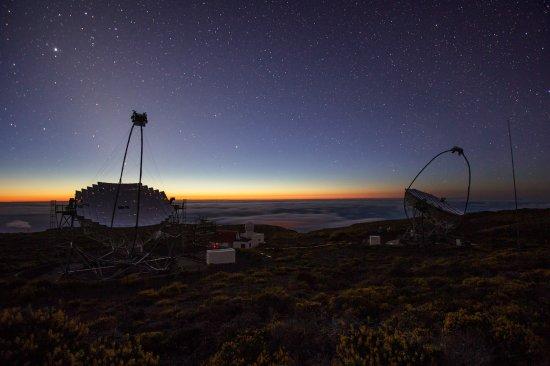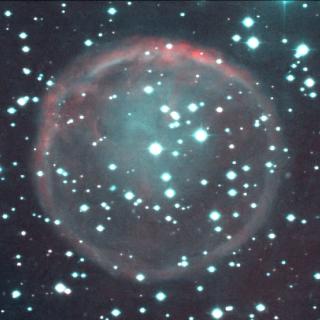On the night of 12th to 13th November 2012 the MAGIC gamma-ray telescopes at the Observatory of the Roque de los Muchachos in the island of La Palma were observing the Perseus cluster of galaxies (which lie at some 260 million light years from us) when they detected an unusual phenomenon coming from one of the galaxies in the cluster, known as IC310: intense flares of gamma-rays of very short duration. IC310, as is very common for galaxies, hosts a supermassive black hole at its centre, various hundreds of millions of times as massive as the Sun. These objects emite sporadic flares of gamma-rays. What surprised the scientists on this occasion was the extreme brevity of the flares, with a duration of only a few minutes.
“Relativity tells us that an object cannot emit radiation for a shorter time than it takes light to travel across it. We know that the black hole in IC310 has a size which is a few times the distance between the Earth and the Sun, some 20 light-minutes. This means that no phenomenon which it produces should last for less than 20 minutes", explains Julian Sitarek, Juan de la Cierva Fellow in the IFAE (Barcelona). Nevertheless, the flares observed from IC310 lasted less than 5 minutes.
The scientists in the MAGIC collaboration suggest a new mechanism whereby this “gamma-ray storm” is produced in regions of vacuum which are produced close to the magnetic poles of the black hole. In these vacuum regions very intense electric fields are created for a very short time, and these are destroyed when the zones are reoccupied by charged particles. In this process the particles are accelerated to velocities very close to the velocity of light, and when they meet photons they transfer some of their energy to them, transforming them into gamma-rays. The time for light to cross these zones is just a few minutes, which fits in with what is observed in IC 310. “It is similar to what happens in electric storms “ explains Oscar Blanch, Ramon and Cajal Fellow of the IFAE and co-spokesman of the MAGIC collaboration. “A potential difference is built up which is so large that it ends by discharging, just like a flash of lightning”. In this case the discharge reaches the highest energies observed in nature, and produces gamma-rays. The black holes seem to be wrapped in a storm of stellar dimensions.
MAGIC telescopes
MAGIC represents the current phase of a young but productive branch of science: gamma-ray astronomy. Its successful presence at the Roque de los Muchachos Observatory of the Instituto de Astrofísica de Canarias dates from the 1980’s with the HEGRA telescopes. The immediate future of the field is with the Cherenkov Telescope Array (CTA) formed by some 100 telescopes distributed in two observatories, in the northern and southern hemispheres. The Spanish groups participating in MAGIC have presented a candidacy to construct the CTA-north observatory at the Roque de los Muchachos or at the Teide Observatory, on Tenerife. This possibility is one of the best opportunities for Spain to host one of the major global scientific installations which will mark the development of astronomy during the coming years.
MAGIC comprises two telescopes with reflecting mirrors of 17 m diameter, built and operated by an international collaboration of 160 scientists in Spain, Germany, Italy, Poland, Switzerland, Finland, Bulgaria, Croatia, Japan and India, and is celebrating its tenth anniversary with the publication of its fifth scientific paper in the journal Science. The principal Spanish contributions to the construction of MAGIC have been the camera of one of the telescopes, a large fraction of the electronics, and the data centre. The quality of the sky over La Palma has contributed to its success.
The participating Spanish institutions are the Institute of High Energy Physics (IFAE) in Barcelona, Autonomous University of Barcelona, the University of Barcelona, the Institute of Space Sciences (CSIC, Barcelona), the Astrophysics Institute of the Canaries (IAC, La Laguna), the Centre for Research in Energy, Environment and Technology (CIEMAT), Madrid and the Complutense University of Madrid.
Additional information about MAGIC: magic.mpp.mpg.de/
Vídeo: "A Lightning Inferno at the Event Horizon". Credits: created by Robert Schulz; based on Science paper by Aleksic et al. 2014.
Scientific publication: Black hole lightning due to particle acceleration at subhorizon scales. Aleksic et al. 2014, Science. DOI:10.1126/science.1256183
Contact at the IAC:
Prof. Ramón García López
Instituto de Astrofísica de Canarias
E-mail: rgl [at] iac.es (rgl[at]iac[dot]es)
Tel: 922 605 209
Other contacts:
Dr. Javier Rico
Instituto de Física de Altas Energías
E-mail: jrico [at] ifae.es (jrico[at]ifae[dot]es)
Tel: 93 164 1661
Prof. Lluis Font
Universidad Autónoma de Barcelona
E-mail: lluis.font [at] uab.es (lluis[dot]font[at]uab[dot]es)
Tel: 93 581 2935
Prof. Josep Maria Paredes
Universidad de Barcelona
E-mail: jmparedes [at] ub.edu (jmparedes[at]ub[dot]edu)
Tel: 93 402 1130
Dra. Emma de Oña-Wilhelmi
Instituto de Ciencias del Espacio (IEEC-CSIC)
E-mail: wilhelmi [at] ieec.uab.es (wilhelmi[at]ieec[dot]uab[dot]es)
Tel: 93 581 4364
Prof. Maria Victoria Fonsenca
Universidad Complutense de Madrid
E-mail: fonseca [at] gae.ucm.es (fonseca[at]gae[dot]ucm[dot]es)
Tel: 91 394 4491
Dr. Carlos Delgado
Centro de Investigaciones Energéticas y Medioambientales
E-mail: carlos.delgado [at] ciemat.es (carlos[dot]delgado[at]ciemat[dot]es)
Tel: 91 496 25 83



